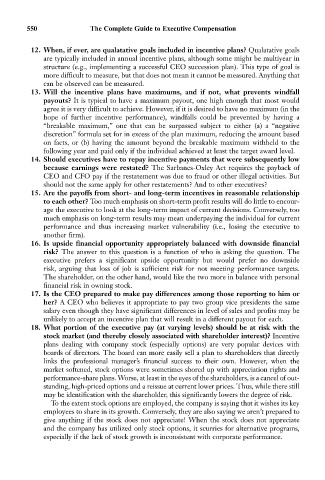Page 564 - Bruce Ellig - The Complete Guide to Executive Compensation (2007)
P. 564
550 The Complete Guide to Executive Compensation
12. When, if ever, are qualatative goals included in incentive plans? Qualatative goals
are typically included in annual incentive plans, although some might be multiyear in
structure (e.g., implementing a successful CEO succession plan). This type of goal is
more difficult to measure, but that does not mean it cannot be measured. Anything that
can be observed can be measured.
13. Will the incentive plans have maximums, and if not, what prevents windfall
payouts? It is typical to have a maximum payout, one high enough that most would
agree it is very difficult to achieve. However, if it is desired to have no maximum (in the
hope of further incentive performance), windfalls could be prevented by having a
“breakable maximum,” one that can be surpassed subject to either (a) a “negative
discretion” formula set for in excess of the plan maximum, reducing the amount based
on facts, or (b) having the amount beyond the breakable maximum withheld to the
following year and paid only if the individual achieved at least the target award level.
14. Should executives have to repay incentive payments that were subsequently low
because earnings were restated? The Sarbanes-Oxley Act requires the payback of
CEO and CFO pay if the restatement was due to fraud or other illegal activities. But
should not the same apply for other restatements? And to other executives?
15. Are the payoffs from short- and long-term incentives in reasonable relationship
to each other? Too much emphasis on short-term profit results will do little to encour-
age the executive to look at the long-term impact of current decisions. Conversely, too
much emphasis on long-term results may mean underpaying the individual for current
performance and thus increasing market vulnerability (i.e., losing the executive to
another firm).
16. Is upside financial opportunity appropriately balanced with downside financial
risk? The answer to this question is a function of who is asking the question. The
executive prefers a significant upside opportunity but would prefer no downside
risk, arguing that loss of job is sufficient risk for not meeting performance targets.
The shareholder, on the other hand, would like the two more in balance with personal
financial risk in owning stock.
17. Is the CEO prepared to make pay differences among those reporting to him or
her? A CEO who believes it appropriate to pay two group vice presidents the same
salary even though they have significant differences in level of sales and profits may be
unlikely to accept an incentive plan that will result in a different payout for each.
18. What portion of the executive pay (at varying levels) should be at risk with the
stock market (and thereby closely associated with shareholder interest)? Incentive
plans dealing with company stock (especially options) are very popular devices with
boards of directors. The board can more easily sell a plan to shareholders that directly
links the professional manager’s financial success to their own. However, when the
market softened, stock options were sometimes shored up with appreciation rights and
performance-share plans. Worse, at least in the eyes of the shareholders, is a cancel of out-
standing, high-priced options and a reissue at current lower prices. Thus, while there still
may be identification with the shareholder, this significantly lowers the degree of risk.
To the extent stock options are employed, the company is saying that it wishes its key
employees to share in its growth. Conversely, they are also saying we aren’t prepared to
give anything if the stock does not appreciate! When the stock does not appreciate
and the company has utilized only stock options, it scurries for alternative programs,
especially if the lack of stock growth is inconsistent with corporate performance.

